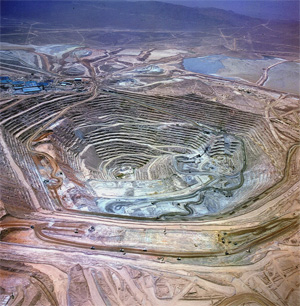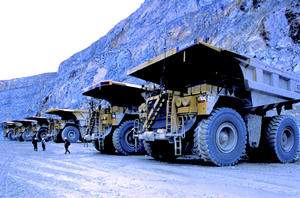Headquartered
in Australia, BHP Billiton has just issued its Annual Report for 2007 in
which its plans for the Olympic Dam copper, gold silver and uranium mine
expansion as an open pit in South Australia are discussed. The company
is a global player in minerals, oil and gas extraction, but although it
has another big copper mine, Escondida in Chile, Olympic Dam is its only
uranium mine.
Currently operating as an underground mine, Olympic Dam was acquired from WMC under the watch of the leaving CEO Chip Goodyear, now passing the leadership to chemical engineer Marius Kloppers, who has appointed Graeme Hunt as President for Uranium and Olympic Dam development, perhaps to be his greatest misfortune.
The rise in the spot price of uranium, which might have added value to the take-over investment in WMC has turned into a disadvantage. The production in the current Olympic Dam underground mine has fallen (and continues to fall) and in order to fill the deficit in supply and fulfil forward selling contracts BHP Billiton is having to buy expensive product on the open market, while earning only the previously negotiated price.
Readers of "The big hole" [1] will know that the expansion project is subject to a pre-feasibility and feasibility study, which took four years ending in 2009, after which if a decision is taken to go ahead in 2010, five years of overburden excavation will proceed the extraction of the first uranium in 2017. Part of the pre-feasibility study has been to find the extent of the deposits by drilling.

Total resource
The drilling results, now included in the 2007 Annual Report [2] indicate a total resource of 7,738 million tonnes of mixed ore containing 67 million tonnes of copper (0.87% grade), 1.9 million tonnes of uranium (0.029% grade U3O8 *), 2,320 tonnes of gold (0.30 grams/tonne) and 12,460 tonnes of silver (1.61 grams/tonne). What must be understood is that to obtain its metal contents this huge amount of ore has to be extracted, milled and chemically processed and that it occurs below 350 metres of overlying rock. Around two to three times the quantity of the ore body will have to be mined and set to one side of the open pit, so that ore extraction can continue unhindered by excessive overburden.
 But
the low grades of all the constituents of the combined ore must be
disappointing to the company, in particular those of the gold and the
uranium. The gold content in South African mines lies between 8 to 10
grams per tonne and costs US$ 12,000/kg to extract. Gold deposits of
0.30 grams/tonne (0.3 ppm) alone would in comparison require the mining
and milling of 27 times the amount of ore, while the extraction process
yield would drop. The costs of extracting gold from such a deposit could
well exceed the current price of gold of US$ 23,000/kg.
But
the low grades of all the constituents of the combined ore must be
disappointing to the company, in particular those of the gold and the
uranium. The gold content in South African mines lies between 8 to 10
grams per tonne and costs US$ 12,000/kg to extract. Gold deposits of
0.30 grams/tonne (0.3 ppm) alone would in comparison require the mining
and milling of 27 times the amount of ore, while the extraction process
yield would drop. The costs of extracting gold from such a deposit could
well exceed the current price of gold of US$ 23,000/kg.
When considering further investment in processing equipment to
produce uranium from ore stocks and tailings as remnants of an
exhausting mine, as at the Ranger mine in the Northern Territory of
Australia, the economic cut-off grade was taken as 0.08% U3O8. In the
case of the Rössing mine, in production in Namibia since 1976, the ore
grade is now only around 0.035% U3O8. Production has continued ever
since, dropping only recently in 2006 to 3,077 tonnes U from 3,147
tonnes U in 2005 and plans to extend its production to 2021 are under
consideration. [3] This must be somewhat incongruous to the part-owners of Ranger and Rössing,
Rio Tinto, which is seemingly applying different economic cut-off
criteria when considering extensions to the two existing mines.
For comparison, there is no current project under review to open a new
mine based on a sole uranium deposit in the same order as the ore grade
(of 0.029% U3O8) in the case of the combined ore in the Olympic Dam
total resource. This is an important consideration when
contemplating the viability of other potential projects in Australia if
there are no co-products in a combined ore augmenting the low uranium
ore grades averaging 0.045%. [4]
In the case of the Olympic Dam expansion the components of the combined ore are extracted by means of an extremely complex set of chemical processes, needing vast quantities of chemicals, water and energy. Moreover the product yield of such processes is never 100%, so the contents of the ore body will not be fully recovered. It turns out that the uranium, far from being an asset, contaminates the copper and has to be removed from it before it can be sold. If exported there would be nuclear proliferation issues as access to uranium could be achieved by separating it from the copper.
No wonder the company has cautiously reminded investors that the expansion is substantial and requires the completion of the feasibility study and board approval.
Combined ore
The officially claimed ore grades anticipated in November 1983 for the Olympic Dam underground mine project were 2.5% copper, 0.08% uranium, 0.60 g/tonne gold and 6.0 g/t silver. Construction commenced in 1986 and the first combined ore was milled in June 1988, 11 years after the first drilling in 1975.
Production of uranium began at 910 tonnes in 1988-89, rising to a peak of 4,500 tonnes in 2000, dropping to 2,867 tonnes in 2002, but reaching a second peak of 4,370 tonnes in 2004. It is now in rapid decline with only 3,382 tonnes produced in 2006. [5] Production of the co-products of copper, gold and silver has declined in parallel. The fall in production is linked to the halving of the ore grades over the last few years of operation, so that when its continuation as an open pit was proposed the anticipated ore grades were 1.0% copper, 0.04% U3O8, 0.45 g/t gold and 2.2 g/t silver.
Although the total resource is now considered to be much bigger than before, leading to even greater media excitement, the ore grades are even lower at, 0.87% copper, 0.029% U3O8, 0.30 g/t gold and 1.61 g/t silver, calling into question the viability of the open pit method, not least because the ore body occurs below 350 metres of rock.
Extraction efficiencies
The extraction of the co-products from the combined ore is an
extremely complex chemical operation. [6] Inevitably such processes do not have a 100% yield. The supplies include
process water, ammonia, diesel, frother, oxygen, cyanide, hydrogen
peroxide, nitric acid, caustic, ferrous sulphate, coke, zinc dust,
silica flux, nitre and as reagents, cobalt and guar gum. Sulphuric acid
is made on site from sulphur dioxide resulting from the copper sulphide
smelting, but may require augmentation.
The historical extraction efficiencies were:
- Copper ca. 90%
- Uranium ca. 65%
- Gold ca. 56.5%
- Silver ca. 54.4%
This means that around 10% of the copper and 35% of the uranium ends up in the tailings pond. [7]
The extraction efficiency for the much reduced grades will be worse and the company is reviewing the chemical processes needed, perhaps with a view to restoring the yields by the introduction of more advanced processes. However, applying the above extraction efficiencies to the contents of the combined ore at the grades now anticipated, the mining and milling of 40 million tonnes per annum (as was originally intended) would produce around:-
- 320,000 tonnes of copper
- 6,440 tonnes of uranium (7,600 tonnes U3O8)
- 6,780 kg gold
- 35,000 kg silver
To restore the anticipated uranium production of 15,000 tonnes a year (U) would mean that the combined ore mined and milled would have to be increased to amount to 93 million tonnes a year instead of 40 Mt/y, though the copper production would increase to 744,000 tonnes.
Because of the lower ore grades of the constituents in the combined ore and other processing factors, it is possible that the uranium extraction efficiency will decline to 40-50% a year, in which case at 40 Mt/y the production would be 4,900 t/y U (5,800 t/y U3O8) and to restore the anticipated production to 15,000 t/y U would require the mining and milling of 122 million tonnes per year.
Since these calculations were performed, the figure claimed for uranium production has escalated to 19,000 tonnes/year U.
Implications
The reduction in ore grades requires a correspondingly inverse increase in the amount of ore to be mined and milled for the same metal production. It also means that the amount of overburden to be removed increases by the same multiplier. Two decades ago the diesel needed for the excavators and haultrucks would have been relatively cheap, but now Australia is a net importer of diesel, now refined from crude oil priced at US$ 70+. One of the advantages of nuclear power is claimed to be its immunity to rising fuel costs and its role as an alternative to liquid fuels for transport by the electrolysis of water for the production of hydrogen. If however, its uranium based fuel is dependent on a doubling or tripling of the amount of diesel needed to produce it, its immunity will be lost. From 2011 to 2016, when 2 billion tonnes of primary overburden will be removed and displaced, the price of diesel can only be conjectured.
Based on the above analysis it is possible that the Olympic Dam expansion may not go ahead, certainly not at the anticipated uranium production rate of 15,000 tonnes per annum. Depending on the price of copper futures in 2017 as set in 2010, it may go ahead on the basis of a restricted copper production of 300,000 tonnes per annum, with a moderate uranium production of 5,000 tonnes a year. Most likely the ore from the open pit, if it goes ahead, will simply be transferred to the existing processing plant, as by then the underground mine will be approaching exhaustion. Whether this moderate continuation of its mining activities would justify the initial investment in overburden removal is somewhat doubtful.
It would be as well in the meantime to warn that the nuclear "renaissance" - if relying on Australian uranium supplies - may well stall. "The big hole" has got bigger, but its size is nothing to that into which the politicians and bullish media will sink when it fails to go ahead, particularly as its uranium product has been "sold" already to the Chinese, the Indians and the Russians. If new fleets of nuclear power stations are to be built on the huge and pretentious projections claimed for the Olympic Dam expansion by politicians and journalists and if the BHP Billiton board indeed turns the project down (as it probably will) there will be much aggravation.
[1] The
big hole
[2] http://www.bhpbilliton.com/bbContentRepository/bhbpannualreport07.pdf
[3] https://www.world-nuclear.org/info/uprod.html
[4] https://pmc.gov.au/publications/umpner/docs/commissioned/ISA_report.pdf
[5] https://www.uic.com.au/emine.htm
[6] https://odx.bhpbilliton.com/docs/OreProcessingFlowDiagram.pdf
[7] Extraction efficiencies are derived from an analysis of quarterly and
annual reports of
WMC (1988 to 2005) and BHP Billiton (2005 to 2007) by Gavin Mudd, Monash University, Melbourne.
* Uranium is shipped as triuranium octoxide (U3O8) or "yellow cake" in drums. The uranium content is found by multiplying the yellow cake weight by 0.848.